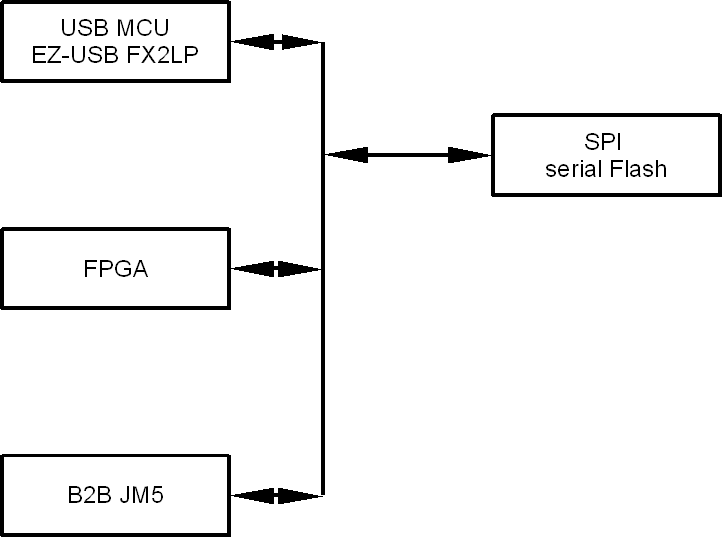TE0320 has a flexible SPI bus on-board as outlined in the figure below.
SPI signals on the TE0320 are listed and described in the table below.
name | definition | description |
SPI_Q | serial data output | This output signal is used to transfer data serially out of the device. Data is shifted out on the falling edge of SPI_/C. |
SPI_D | serial data input | This input signal is used to transfer data serially into the device. It receives instructions, addresses, and the data to be programmed. Values are latched on the rising edge of SPI_/C |
SPI_/C | serial clock | This input signal provides the timing of the serial interface. Instructions, addresses, or data present at SPI_D are latched on the rising edge of SPI_/C. Data on SPI_Q changes after the falling edge of SPI_/C. |
SPI_/S | chip select | When this input signal is high, the device is disabled and SPI_Q is at high impedance (Z). |
|
| When this input signal is low, the device is enabled. |
|
| After power-up, a falling edge on SPI_/S is required prior to the start of any instruction to the Flash memory. |
SPI signal pin-out of the TE0320 is summarized in the table below.
name | FPGA ball | JM5 pin |
|---|---|---|
SPI_Q | AF24 | 18 |
SPI_D | AB15 | 12 |
SPI_/C | AE24 | 22 |
SPI_/S | AA7 | 20 |
SPI pins on B2B connector JM5 cannot be used as GPIOs (general purpose I/Os).
The SPI bus can be used during configuration and operation in a plurality of ways as summarized respectively in Table A (SPI bus for configuration) and Table B (SPI bus for operation).
SPI bus for configuration
The SPI bus is used for configuration in two ways by default:
- EZ-USB â-º Flashthe USB FX2 microcontroller (master) writes the PROM file (containing the FPGA configuration bitstream) to the SPI serial Flash memory (slave)
- FPGA â—„ Flashthe FPGA (master) configures itself in Master SPI mode from the SPI serial Flash memory (slave).
In case (a), the FPGA shall be turned off to release its shared SPI pins.
In case (b), the USB FX2 microcontroller shall three-state (Z = high impedance) its shared SPI pins.
description | usage | EZ-USB FX2LP | FPGA | B2B JM5 | serial Flash |
|---|---|---|---|---|---|
EZ-USB â-º Flash | OpenFUT | master | off | deselected | slave |
FPGA â—„ Flash | OpenFUT | inactive | master | deselected | slave |
B2B JM5 â-º Flash | custom | inactive | off | master | slave |
The PROM file (containing the FPGA configuration bitstream) can be written to the SPI serial Flash memory (slave) also through the SPI pins of B2B connector JM5 (attached device set to master mode). In this case, the FPGA shall be turned off or three-stated to release its shared SPI pins and the USB FX2 microcontroller shall three-state (Z = high impedance) its shared SPI pins.
SPI bus for operation
A plurality of usage combinations of the SPI bus during operation is made available to the user as suggested in Table B below.
description | usage | EZ-USB FX2LP | FPGA | B2B JM5 | serial Flash |
EZ-USB â—„â-º Flash | custom | master | off | deselected | slave |
FPGA â—„â-º Flash | custom | inactive | master | deselected | slave |
B2B JM5 â—„â-º Flash | custom | inactive | off | master | slave |
EZ-USB â—„â-º B2B JM5 | custom | master | off | slave | deselected |
EZ-USB â—„â-º B2B JM5 | custom | slave | off | master | deselected |
